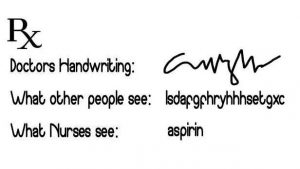NEWS AND UPDATES
Handwriting Matters: study illustrates causes and effects of doctors’ poor handwriting
Doctors are often stereotyped for their bad handwriting. According to a study, this illegibility of doctors’ handwriting in medical prescriptions is often the cause of medication errors.
Proper writing of prescriptions involves a strict format which includes superscription, inscription, subscription, and transcription, the researchers of the study explained. Superscription refers to the date of prescriptions, Rx symbol, and details of patients, inscription to the name and amount of medicine, subscription to instructions to pharmacists, while transcription to other notes and directions for use.
However, a study published by the Philippine Council for Health Research and Development (PCHRD) found out that 28% of Filipino patients considered their doctors’ handwriting in prescriptions unreadable which led to adverse medical consequences such as administration of improper dosage of medicine, and even death.
To evaluate the readability of the penmanship of doctors and identify their most common misinterpreted words, researchers from the University of the Philippines Diliman randomly selected 45 licensed doctors with different specializations from Quezon City hospitals to write prescriptions. Groups of 80 assessors consisting of pharmacists, young adults (20-34 years old), middle-aged adults (35-49 years old), and senior citizens (50 years old and up) were given these prescriptions to assess.

The results showed that doctors have similar handwriting regardless of their specializations wherein abbreviations in the prescriptions contribute to most of the errors. Pharmacists are most likely to interpret prescriptions correctly among the assessing groups in the study.
The researchers explained that majority of the poor handwriting of doctors is attributed to the times when doctors are in a rush when writing prescriptions, during their rounds or peak hours, or when they experienced fatigue.
“Common medication errors cover the writing of prescription, transcribing these prescriptions, and administering the medications…majority is attributed to the writing [which] …is rooted mainly to the illegible handwriting of the doctors,” the researchers explained. Medication error is any preventable event that may pose harm to the patients.
To prevent medication errors due to poor handwriting of doctors, the researchers suggested developing a program on writing prescriptions that can be easily understood by everyone. They also pointed out that abbreviations in prescriptions should be avoided as they lead to more confusion. Lastly, the researchers advised adapting a computerized prescription system if possible.
The study “Assessment of the legibility of the handwriting in medical prescriptions of doctors from public and private hospitals in Quezon City, Philippines” is available at Science Direct and can be accessed at http://www.sciencedirect.com/science/article/pii/S2351978915001134.




